Though our bones are very strong; there are several activities that put tremendous pressure on different bones of the body. A bone is susceptible to injury, which may cause a bone to fracture. The different types of bone fractures are explicated in this article.

A bone fracture is medically defined as the loss of continuity of the bone, which may be the result on account of a hairline fissure, deracination, or fragmentation of the bone. A fracture, often is caused when undue, or intense compression/pressure impacts the bone. Different bones in the body have varied tolerance levels and the capacity to endure stress. Each bone has its own threshold value, which, when crossed by the pressure exerted, terminates in a fracture.
INDEX
- Degree of Luxation
- Causative Factors
- Types of Bone Fractures
- Anatomical Classification
Factors Affecting Degree of Luxation
Before we learn about the types of bone fractures, let us consider different factors that affect the degree of bone luxation and laceration.
Age: The elderly are far susceptible to fractures than the pediatric population since their bones become brittle through senescence. Children rarely suffer from fractures; their bones are agile.
Health: Diet can greatly affect the health of your bones, and hence make you more or less susceptible to bone fractures.
Occupation: Athletes are more prone to instances of bone dislocation than people with sedentary jobs, homemakers, etc.
Type of bone: Different bones in the body have different capacities to bear impact, and hence vary in degree of susceptibility to fractures.
Nature of impact: It is the amount and direction of force or pressure that the bone was subjected to -- in other words, the momentum.
Causative Factors
Fractures may be classified by the nature of their respective causes.
Traumatic Fracture
Normally, people suffer from a traumatic fracture as a result of them having performed an activity that subjected the bone to enduring excessive pressure, stress, or a deep impact -- for instance, a fall, or a vehicular accident. A person, governed by good health and body constitution, too, may suffer from such a fracture.
Pathological Fracture
Certain medical conditions, such as osteopenia, osteoporosis, bone marrow cancer, bone cyst, or inherited bone disorders debilitate the bones to such an extent that a superficial impact, too, may cause the bones to fracture. These fractures are different from normal fractures, in that the impact involved in causing the fracture is rather superficial. A break in the bone, endured when the bone is either declared morbid, or abnormal is termed pathological fractures.☝[
Wheel Back ]
Types of Bone Fractures
A common way to classify bone fractures is on the basis of different features of a fracture. This is known as orthopedic classification. Bone fractures that consider the above definition as a foundation to their diagnostic individuality are explicated herein.
Broad Classification
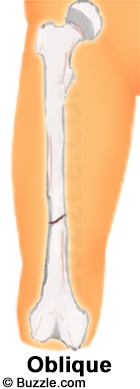
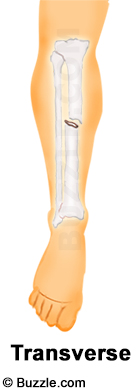
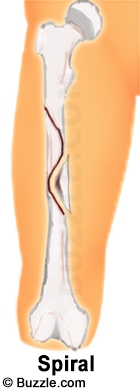
❑ Oblique fracture: A type of fracture where the fissure runs diagonal to the axis of the bone.
❑ Transverse fracture: A fracture caused is right angled to the axis of the bone.
❑ Spiral fracture: A section of the bone has endured luxation.

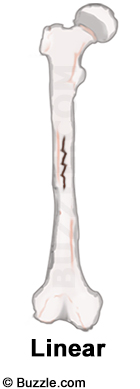

❑ Comminuted fracture: Also known as multi-fragmentary fracture, the crack results in several fragments of the bone.
❑ Linear fracture: Here, the fracture is parallel to the bone's long axis.
❑ Greenstick fracture: A partial fracture where one side of the bone remains intact, and a torsion is borne by the other side.


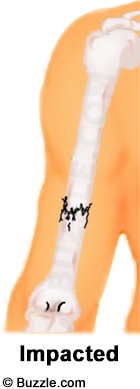
❑ Simple fracture: Also known as a closed fracture, it is a fracture where the bone suffers breakage; however, it does not puncture, or pierce through the epidermis.
❑ Compound fracture: Also known as an open fracture, this form of bone trauma is characterized by luxation of the bone, with it being exposed to contamination. This is dangerous as the plausibility of contracting an infection is dense.
❑ Impacted fracture: It is a closed fracture which occurs when pressure is applied to the two extremities of the bone, causing it to split into two fragments that jam into each other. This type of fracture is a common resultant of motor collisions and falls.
Other Types of Fractures
❑ Complete fracture: A fracture marked by complete fragmentation of the bone.
❑ Incomplete fracture: In this, the two pieces of the bone, resulting from the fracture partially avulsed from each other; the portions are radially joined to some extent. This happens when the pattern of laceration does not segment the bone completely.
❑ Compression fracture: A compression fracture is a closed fracture that occurs when two or more bones are forced against each other. It commonly, is endured by the bones of the spine and may be caused when the anterior portion of the vertebra collapses while standing or sitting, or as a result of advanced osteoporosis.
❑ Avulsion fracture: An avulsion fracture is a closed fracture where a piece of bone is broken off by a fulminant, forceful contraction of a muscle. This type of fracture is common in athletes and can occur when no warm-ups prelude the upcoming strenuous activity.
❑ Stress fracture: It is a common overuse injury. It is most often seen in athletes who run and jump on hard surfaces, such as runners; ballet dancers; and basketball players.
❑ Compacted fracture: Here, the fracture is caused when a fragmentary propulsion of the bone occurs.
❑ Displaced fracture: The bone snaps into two parts in such a manner that the bone ceases to maintain alignment.
❑ Non-displaced fracture: This is when the bone cracks; however, it remains aligned and positioned.
❑ Hairline fracture: This is when the torsional force is insufficient to cause major trauma to the bone, so as to not let the bone fragmentize.
❑ Fatigue fracture: When mundane stressors display an incremental tendency, thereby building up on the foundation of your health, it may be traumatizing for your bones. This leads to damage and subsequent weakness with the passage of time.☝[
Wheel Back ]
Anatomical Classification
☛ Skull Fractures
A fracture or break in the cranial portion courtesy of a torsion force, which predominantly leads to a concussion; however, the trauma may or may not lead to losing consciousness. The four types of skull fractures are mentioned herein.
» Linear fracture of the skull: A break in the bones of the skull that affects the surface area of the skull. In most cases, surgical intervention is not required.
» Depressed fracture: A type of multi-fragment skull fracture, it is caused when a blunt force is exerted, also marked by luxation of the bone and damage of conterminous tissues, thereby implying surgical intervention.
» Diastatic fracture: A fracture that results in extending of the sutures due to the fracture spanning the surface area of the skull and affecting the joints or sutures of the skull.
» Basilar skull fracture: When the base of the skull sustains intense trauma, which causes the membranes casing the brain to rupture.
» Blowout fracture: A break sustained in the orbital (eye) region, which may or may not cause torsion at the floor or the medial walls of the orbit.
» Mandibular fracture: A trauma sustained by the mandibular bone or at the site of the jaw, generally manifested due to a voluntary or involuntary participation in a scrimmage or altercation.
» Nasal fracture: A fracture caused due to a physical injury sustained by the cranionasal region, often accompanied with contusion and epistaxis. Due to the natural occlusion of the nose, the anterior nares are most susceptible to trauma.
» Le Forte fractures: Craniofacial fractures that affect the maxillary bone in a horizontal, transverse, or pyramidal mode of dissociation.
☛ Spinal Fractures
Traumas that affect the vertebral column are regarded as spinal fractures. The major types of spinal fractures are mentioned herein.
» Cervical fracture: When any of the seven cervical vertebrae sustain immense trauma, the result is a broken neck, medically articulated as a cervical fracture.
» Flexion Teardrop fracture: An intense trauma to the spinal column, courtesy of the digressive movement of the spine, marked by deracination of the dorsal region of the vertebral column.
» Clay-shoveler's Fracture: A fracture sustained in the spine in the dorsal region, affecting the sagittal plane of the cervical, or lumbar portion as a result of potent destructive agents.
» Chance fracture: A fracture sustained by the ventral and dorsal portions of the vertebral body, also affecting the transverse section of the vertebra.
» Compression fracture: A fracture that marks the prostration of the vertebra caused due to an intensely destructive laceration or debilitation of the vertebra.
» Burst fracture: A vertebral injury that results in complete luxation of the vertebra, wherein, in certain cases, the vertebra sustains a multi-fragmentary fracture due to massive compression or force, leading to laceration of tissue due to vertebral fragment perforation.☝[
Wheel Back ]
☛ Rib Fracture
A fracture that alters the bone structure affecting one or more bones of the rib cage. Trauma sustained due to contact sports, progressive spasmodic spells of coughing, or even due to affliction of degenerative conditions, such as osteoporosis may cause a rib to fracture.
☛ Sternal Fracture
Fracture of the sternum, which is central to the body, is either caused due to vehicular collision, or weakness in the sternal bones.
☛ Shoulder Fractures
Fracture of one or more bones that constitute the acromial region. There are two major bones that constitute the shoulder: (1) Clavicle; and (2) Scapula.
» Clavicle fracture: It is a type of fracture that affects the collarbone or the clavicle caused by trauma, resulting in severe luxation, or snapping of the bone.
» Scapula fracture: A fracture that affects the shoulder blade or the scapula. The cases of scapula fractures are rare as only a massive trauma to the region may cause the bone to fracture.
☛ Arm Fractures
Fractures that involve the bones of the upper arm or the brachial region to be dislocated, or endure a lack of continuity of the bone.
» Humerus fracture: An injury to the bone located in the brachial region.
- Proximal humerus fractures: They affect the site near the shoulder joint.
- Mid-shaft humerus fractures: They occur lateral to the shoulder and elbow joints. Distal fractures occur proximal to the cubital region.
☛ Forearm Fractures
A forearm fracture may be classified in accordance with which the bone of the antebrachial portion has sustained contusion or luxation.
» Ulna fracture: Fracture that is caused due to the ulna, accidentally colliding, or being obstructed with/by an object. Types of ulna fracture include the Hume fracture and Monteggia fracture.
» Radius fracture: Also known as distal radius fracture, it occurs when the radius, proximal to the carpal region, suffers a lesion. The types of radial fractures include Essex-Lopresti fracture, Galeazzi fracture, Colles' fracture, Smith's fracture, and Barton's fracture.☝[
Wheel Back ]
☛ Hand Fractures
The region spanning the carpal, the palmer, and distal portion endures a bone laceration.
» Scaphoid Fracture: A fracture of the scaphoid bone, which leads to inflammation and a palpitating ache at the floor of the thumb.
» Rolando fracture: It is the comminution at the articular surface at the base of the thumb, maybe accompanied with multi-fragmentary tendency of bone fracture. The intensity maybe judged on the grounds of the degree of comminution occurring at the articular surface
» Bennett's fracture: A fracture that occurs at the floor of the thumb, regarded as the first metacarpal bone; and the wrist or the carpometacarpal joint also known as the trapezium.
» Boxer's fracture: Also known as brawler's fracture, this type of bone breakage hampers the continuity of the metacarpophalangeal joint.
☛ Pelvic Fracture
A fracture that affects the structure of the pelvis due to accidental contact with massive intensity due to a catastrophic vehicular collision, or falling from a height.
» Duverney fracture: It is a type of pelvic fracture that occurs due to a deep trauma specifically to the iliac wing.
☛ Femoral Fracture
A luxation of the femur bone that spans from the coxal (hip) region to the condyloid articulatio genus region (knee joint). Only a significant amount of force has the potency to create torsion in the region.
☛ Patella Fracture
A laceration of the kneecap, courtesy of sustaining a trauma.
☛ Crus Fractures
Fracture of the tibia, or the fibula or both; they comprise the crural region.
» Tibia Fractures: A loss of continuity in the shinbone, occurring due to a major impact endured by the tibia. The three types of tibia fractures are as follows:
- Tibial Shaft fracture: One that affects the region between articulatio genus (knee joint) and the articulatio talocruralis (ankle joint).
- Tibial Plateau fracture: It luxates the tuberous region of the tibia also known as the tibial plateau.
- Tibial Plafond fracture: A break in bone continuity occurring at the tarsal site (where the shinbone ends), leading toward the inferior portion of the body, i.e., involving the articulatio talocruralis (ankle joint).
» Fibula Fractures: A loss of continuity of the fibula bone due to a trauma to the crural region. The four types of fibula fractures are the following:
- Maisonneuve fracture: A spiral luxation that damages the tibial malleolus with the distal tibiofibular syndesmosis, thereby also affecting the stability of the fibula shaft.
- Le Fort fracture of the Tarsal Region: An avulsion fracture of the tibio-fibular ligament synthesized with an avulsion at the site of the anterior portion of the distal fibula.
- Bosworth fracture: It is a type of fibular luxation marked by torsional deracination of the talus caused due to fibrillation, or acute rotary motion of the ankle.
» Tib-Fib Fractures: Damage to the tibia and the fibula may result in tib-fib fractures. There are three types of fractures grouped in this category.
- Trimalleolar fracture: It is a fracture of the talus and the posterior malleolus along with deracination of the ligament.
- Bimalleolar fracture: A luxation that involves torsion to the interior portion of the ankle and the medial malleolus.
- Pott's fracture: Loss of bone continuity due to a high-intensity pressure inflicted upon the deltoid ligament, characterized by a fulminant avulsion of the medial malleollus.
☝[
Wheel Back ]☛ Foot Fractures
Luxation, or avulsion of the bones that comprise the pedal and the plantar region of the body.
» Lisfranc fracture: A traumatic episode of torsional luxation of the 5 metatarsal bones of the forefoot and the junction they formulate with the 5 tarsus bones of the midfoot -- these being three cuneiform bones, one cuboid, and one navicular synthesizing into the 5 tarsometatarsal articulations. It, primarily is caused due to vehicular collisions.
» Jones fracture: A fracture sited at the floor of the small toe known as the fifth metatarsal. It may be misdiagnosed as a case of convolution of the ankle.
» Pseudo-Jones fracture: Luxations of the lateral region of the tarsal marked by an abduction eversion force endured by the ankle.
» March fracture: Regarded as a stress fracture, it is a trauma involving the second, or the third metatarsal diaphysis caused due to exercising for stretched periods.
» Calcaneal fracture: A bilateral trauma that is endured by the heel bone or calcaneus of the foot caused due to an accident where the premier impaction is borne by the calcaneus.
Depending on the type of bone fracture, the healing time of the fracture, as well as the treatment suggested by the practitioner may vary. A thumb rule, however, is to give the fractured bone complete rest and to preclude or isolate it from experiencing any type of pressure or stress.


 A bone fracture is medically defined as the loss of continuity of the bone, which may be the result on account of a hairline fissure, deracination, or fragmentation of the bone. A fracture, often is caused when undue, or intense compression/pressure impacts the bone. Different bones in the body have varied tolerance levels and the capacity to endure stress. Each bone has its own threshold value, which, when crossed by the pressure exerted, terminates in a fracture.
A bone fracture is medically defined as the loss of continuity of the bone, which may be the result on account of a hairline fissure, deracination, or fragmentation of the bone. A fracture, often is caused when undue, or intense compression/pressure impacts the bone. Different bones in the body have varied tolerance levels and the capacity to endure stress. Each bone has its own threshold value, which, when crossed by the pressure exerted, terminates in a fracture.







